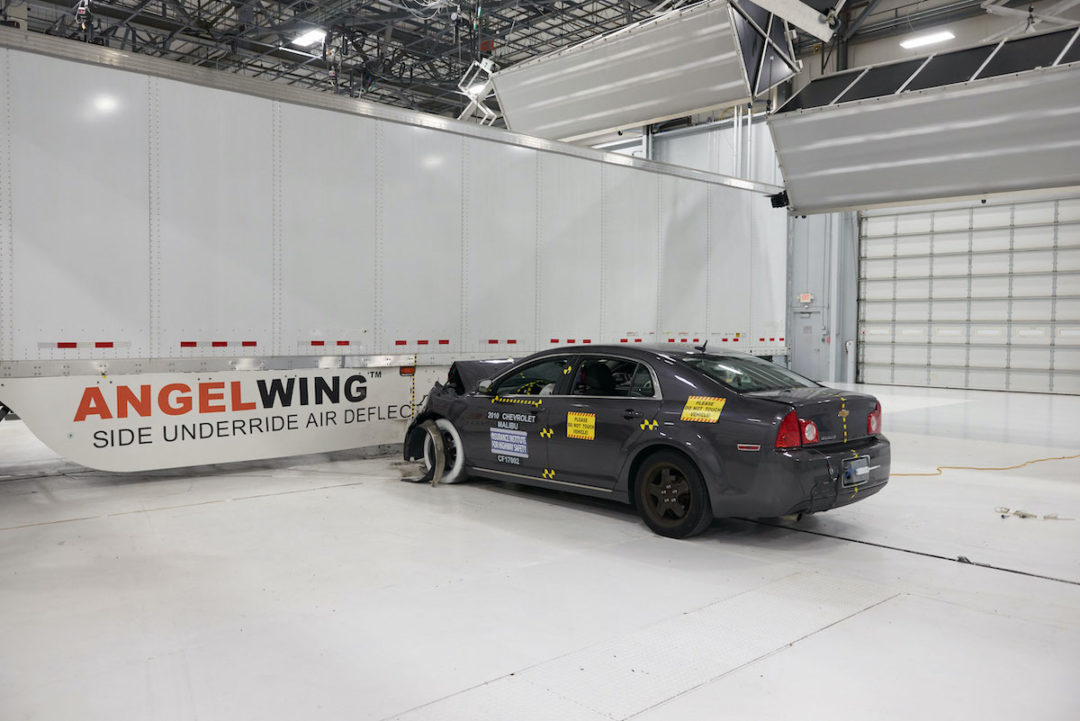
Visit Our Sponsors |
|
|
|
|
|
|
|
|
|
|
|
|
|
|
|
|
|
|
|
|
|
|
|
|
|
|
|
|
|
|
|
|
|
|
|
|
|
|
|
|
|
|
|
|
|
|

The AngelWing side underride guard from Airflow Deflector, Inc. successfully prevented underride in a 2017 IIHS crash test featuring a midsize car striking the guard at 35 mph. Photo: Insurance Institute for Highway Safety
Prominent national organizations are taking very different stances on a potential rule proposed by the U.S. National Highway Traffic Safety Administration (NHTSA) that would require newly built large trucks to use side underride guards.
In favor of the mandate, the Insurance Institute for Highway Safety (IIHS), said that the NHTSA greatly underestimated how many lives the rule could protect, claiming side underride guards could save 10 times as many lives as the NHTSA initially projected. By contrast, the Owner-Operator Independent Drivers Association (OOIDA) said installation of side underride guards would not only be costly and impractical, but the proposed mandate ignores safety, economic and operational concerns previously raised by small-business truckers.
Underride guards are installed below the sides of truck trailers in order to prevent smaller vehicles from sliding underneath during road accidents. The NHTSA proposed a rule April 23, 2023, partly in response to a petition for rulemaking from Marianne Karth and the Truck Safety Coalition. The NHTSA closed the period for public comments July 20, 2023.
The IIHS is a non-profit that represents more than 100 insurance groups and is dedicated to reducing deaths and injuries caused by motor vehicle accidents. The organization said the NHTSA’s predictions did not highlight many types of “likely relevant” crashes, including accidents that involve more than a single passenger vehicle and a single tractor-trailer, as well as collisions that occur at speeds exceeding 40 mph. The NHTSA projected that equipping all new large trucks in the U.S. with side underride guards could prevent 17 fatalities and 69 serious injuries each year. However, through an alternative prediction method, the IIHS estimates the mandate could actually prevent up to 217 deaths annually.
OOIDA, with more than 150,000 members that collectively own and operate over 240,000 individual heavy-duty trucks, says implementing the rule is impractical. "Nobody cares about road safety more than truck drivers, and every single truck driver wants to operate in a safe environment to return home, just like drivers in passenger vehicles. The NHTSA has consistently concluded a federal mandate would be impractical and costly, thus outweighing any safety benefits,” said OOIDA president Todd Spencer in comments submitted to the NHTSA.
The NHTSA projected that equipping all new large trucks in the U.S. with side underride guards would cost roughly $778 million. But OOIDA said that excludes additional expenses associated with reinforcing trailers or changing trailer loading patterns. Extra operating costs could result from repairs made to guards caused by poor road conditions or more difficult vehicle safety inspection processes that could prevent examiners from detecting certain types of equipment malfunctions, Spencer said. He added that any potential mandate also fails to recognize other issues limiting the practicality of side underride guards, such as the risk of grounding or damaging trucks when driving over railroad crossings with tall “humps.”
“Any move by the agency to advance such a measure is premature and shortsighted,” Spencer added.
Other countries have already introduced underride protections similar to the proposed U.S. mandate. Since the enhancement of safety standards in 2007, Canadian trucks have been obliged to install underride guards that can withstand about two times the force of U.S. underride guards, according to a blog post from the Reiff Law Firm. Meanwhile, the EU has required trucks to have front and side underride guards since 1994. In the U.S., only rear underride guards are currently required, by a law introduced January 11, 2023.
“A number of safety advocates have declared guards like this a win-win-win solution because everyday drivers win through improved safety and reduced injuries when an accident occurs,” the law firm said. “Trucking companies win because, when an accident occurs, injuries are less severe, and the truck and cargo are likely to suffer reduced damage. Likewise, the client of the trucking company also wins because their cargo or goods are better protected and less likely to be damaged or destroyed due to the accident.”
RELATED CONTENT
RELATED VIDEOS
Timely, incisive articles delivered directly to your inbox.






